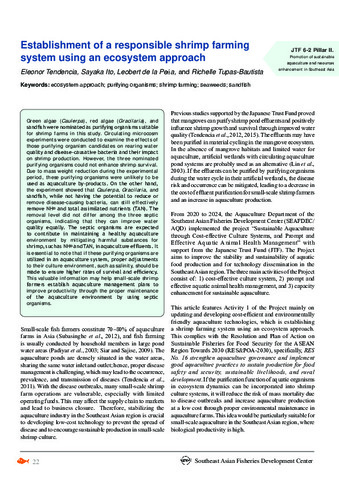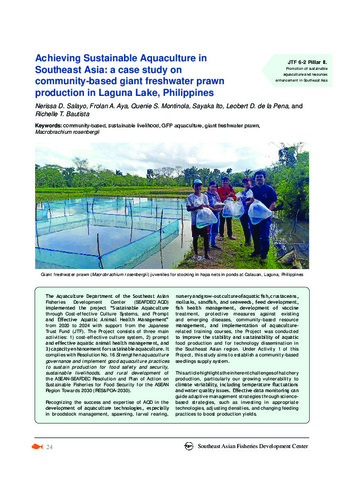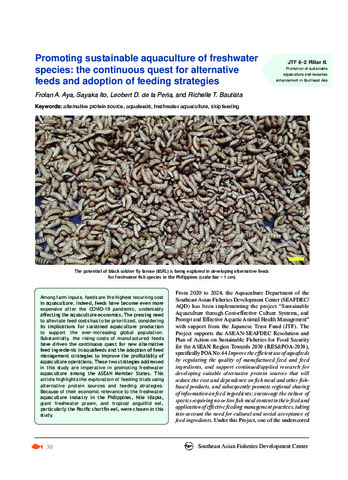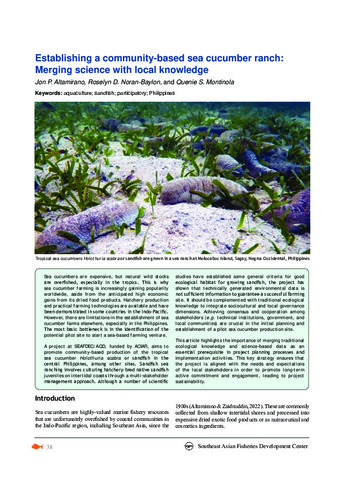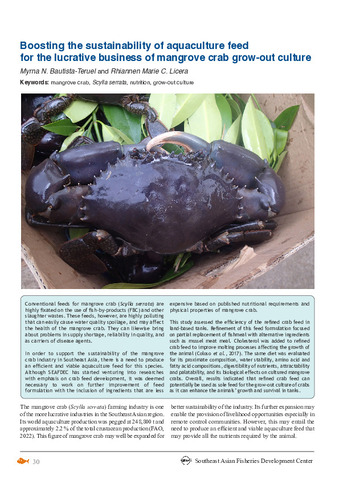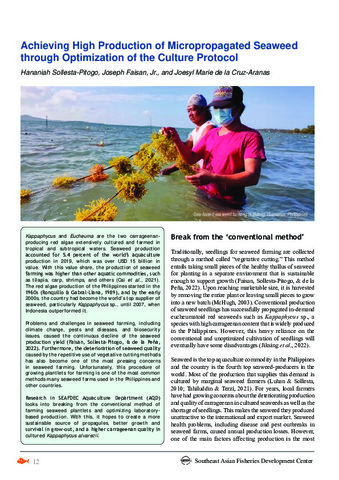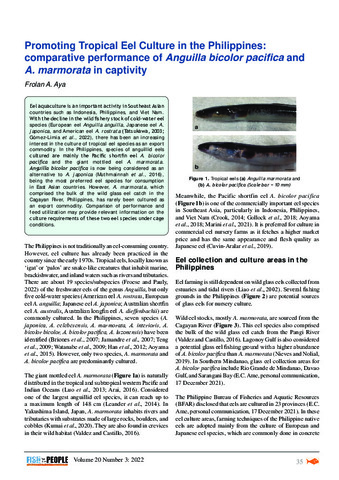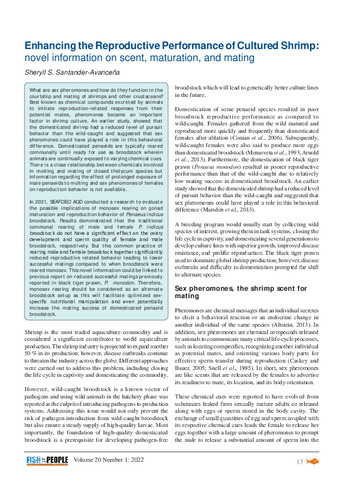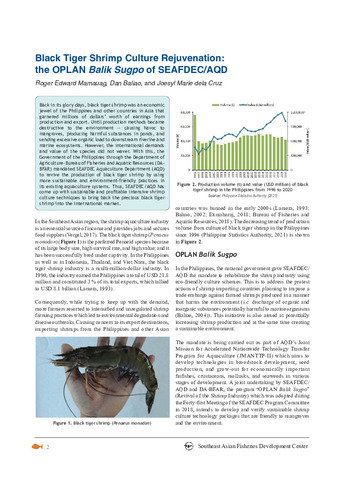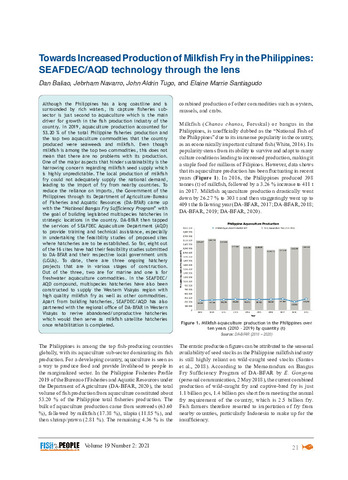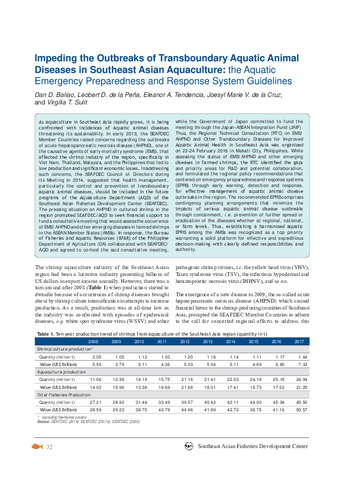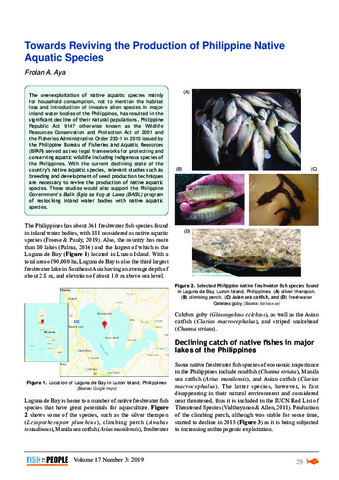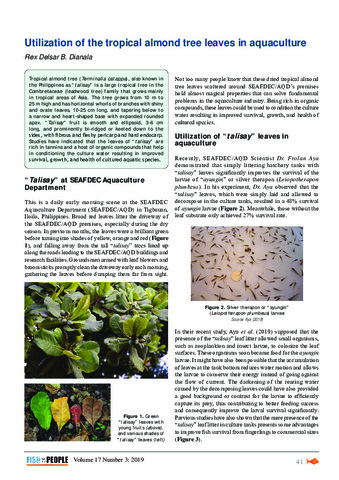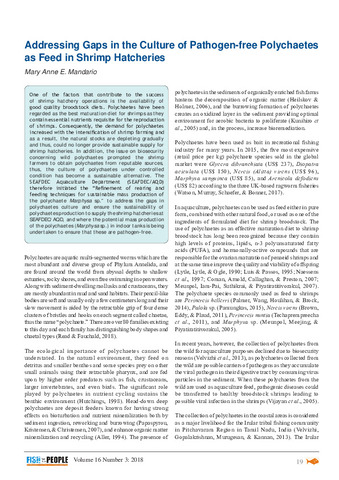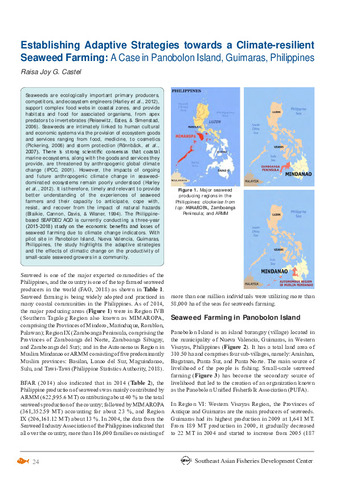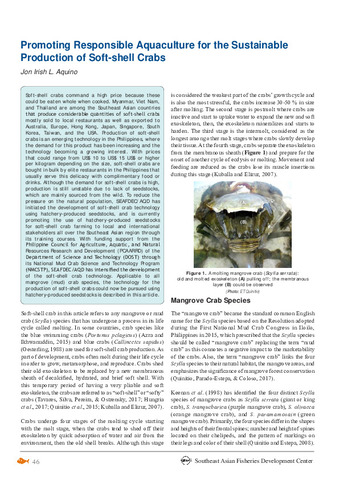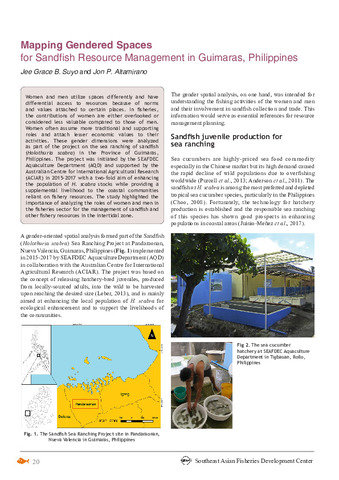Fish for the People
Browse by
Recent Submissions
-
Development of aquaculture techniques on new aquatic species to create and promote a local aquaculture industry in Southeast Asia
(Secretariat, Southeast Asian Fisheries Development Center, 2024-12)Aquaculture achieved a significant milestone in 2022, surpassing capture fisheries production as the leading aquatic producer. Its global production reached 130.9 million t, with 94.4 million t comprising aquatic animals, ... -
Establishment of a responsible shrimp farming system using an ecosystem approach
(Secretariat, Southeast Asian Fisheries Development Center, 2024-12)Green algae (Caulerpa), red algae (Gracilaria), and sandfish were nominated as purifying organisms suitable for shrimp farms in this study. Circulating microcosm experiments were conducted to examine the effects of those ... -
Achieving sustainable aquaculture in Southeast Asia: A case study on community-based giant freshwater prawn production in Laguna Lake, Philippines
(Secretariat, Southeast Asian Fisheries Development Center, 2024-10)The Aquaculture Department of the Southeast Asian Fisheries Development Center (SEAFDEC/AQD) implemented the project “Sustainable Aquaculture through Cost-effective Culture Systems, and Prompt and Effective Aquatic Animal ... -
Promoting sustainable aquaculture of freshwater species: The continuous quest for alternative feeds and adoption of feeding strategies
(Secretariat, Southeast Asian Fisheries Development Center, 2024-10)Among farm inputs, feeds are the highest recurring cost in aquaculture. Indeed, feeds have become even more expensive after the COVID-19 pandemic, undeniably affecting the aquaculture economics. The pressing need to alleviate ... -
Establishing a community-based sea cucumber ranch: Merging science with local knowledge
(Secretariat, Southeast Asian Fisheries Development Center, 2024-07)Sea cucumbers are expensive, but natural wild stocks are overfished, especially in the tropics. This is why sea cucumber farming is increasingly gaining popularity worldwide, aside from the anticipated high economic gains ... -
Boosting the sustainability of aquaculture feed for the lucrative business of mangrove crab grow-out culture
(Secretariat, Southeast Asian Fisheries Development Center, 2023-12)Conventional feeds for mangrove crab (Scylla serrata) are highly fixated on the use of fish-by-products (FBC) and other slaughter wastes. These feeds, however, are highly polluting that can easily cause water quality ... -
Achieving high production of micropropagated seaweed through optimization of the culture protocol
(Secretariat, Southeast Asian Fisheries Development Center, 2023-07)Kappaphycus and Eucheuma are the two carrageenanproducing red algae extensively cultured and farmed in tropical and subtropical waters. Seaweed production accounted for 5.4 percent of the world’s aquaculture production in ... -
Promoting tropical eel culture in the Philippines: Comparative performance of Anguilla bicolor pacifica and A. marmorata in captivity
(Secretariat, Southeast Asian Fisheries Development Center, 2023-02)Eel aquaculture is an important activity in Southeast Asian countries such as Indonesia, Philippines, and Viet Nam. With the decline in the wild fishery stock of cold-water eel species (European eel Anguilla anguilla, ... -
Enhancing the reproductive performance of cultured shrimp: novel information on scent, maturation, and mating
(Secretariat, Southeast Asian Fisheries Development Center, 2022-07)What are sex pheromones and how do they function in the courtship and mating of shrimps and other crustaceans? Best known as chemical compounds excreted by animals to initiate reproduction-related responses from their ... -
Black tiger shrimp culture rejuvenation: the OPLAN Balik Sugpo of SEAFDEC/AQD
(Secretariat, Southeast Asian Fisheries Development Center, 2021)Back in its glory days, black tiger shrimp was an economic jewel of the Philippines and other countries in Asia that garnered millions of dollars’ worth of earnings from production and export. Until production methods ... -
Towards increased production of milkfish fry in the Philippines: SEAFDEC/AQD technology through the lens
(Secretariat, Southeast Asian Fisheries Development Center, 2021)Although the Philippines has a long coastline and is surrounded by rich waters, its capture fisheries subsector is just second to aquaculture which is the main driver for growth in the fish production industry of the ... -
Enhanced biosecurity measures for sustainable aquaculture: Shrimp hatchery operations
(Secretariat, Southeast Asian Fisheries Development Center, 2021-01-30)Long before the COVID-19 pandemic, the Broodstock Facility and Shrimp Hatchery Complex of SEAFDEC Aquaculture Department (AQD) in Tigbauan, Iloilo, Philippines, has already been practicing the best quarantine protocols. ... -
Exploring the aquaculture potential of ayungin, an endemic freshwater fish in the Philippines
(Secretariat, Southeast Asian Fisheries Development Center, 2021-01-30)In the early 1960s, silver therapon (Leiopotherapon plumbeus), locally known as ayungin, is regarded as one of the most abundant freshwater fishery resources in the largest lake in the Philippines, Laguna de Bay. Smallscale ... -
Impeding the outbreaks of transboundary aquatic animal diseases in Southeast Asian aquaculture: The aquatic emergency preparedness and response system guidelines
(Secretariat, Southeast Asian Fisheries Development Center, 2020)As aquaculture in Southeast Asia rapidly grows, it is being confronted with incidences of aquatic animal diseases threatening its sustainability. In early 2013, the SEAFDEC Member Countries raised concerns regarding the ... -
Towards reviving the production of Philippine native aquatic species
(Secretariat, Southeast Asian Fisheries Development Center, 2019)The overexploitation of native aquatic species mainly for household consumption, not to mention the habitat loss and introduction of invasive alien species in major inland water bodies of the Philippines, has resulted in ... -
Utilization of the tropical almond tree leaves in aquaculture
(Secretariat, Southeast Asian Fisheries Development Center, 2019)Tropical almond tree (Terminalia catappa), also known in the Philippines as “talisay” is a large tropical tree in the Combretaceae (leadwood tree) family that grows mainly in tropical areas of Asia. The tree grows from 10 ... -
Addressing gaps in the culture of pathogen-free polychaetes as feed in shrimp hatcheries
(Secretariat, Southeast Asian Fisheries Development Center, 2018)One of the factors that contribute to the success of shrimp hatchery operations is the availability of good quality broodstock diets. Polychaetes have been regarded as the best maturation diet for shrimps as they contain ... -
Establishing adaptive strategies towards a climate-resilient seaweed farming: A case in Panobolon Island, Guimaras, Philippines
(Secretariat, Southeast Asian Fisheries Development Center, 2018)Seaweeds are ecologically important primary producers, competitors, and ecosystem engineers (Harley et al., 2012), support complex food webs in coastal zones, and provide habitats and food for associated organisms, from ... -
Promoting responsible aquaculture for the sustainable production of soft-shell crabs
(Secretariat, Southeast Asian Fisheries Development Center, 2018)Soft-shell crabs command a high price because these could be eaten whole when cooked. Myanmar, Viet Nam, and Thailand are among the Southeast Asian countries that produce considerable quantities of soft-shell crabs mostly ... -
Mapping gendered spaces for sandfish resource management in Guimaras, Philippines
(Secretariat, Southeast Asian Fisheries Development Center, 2018)Women and men utilize spaces differently and have differential access to resources because of norms and values attached to certain places. In fisheries, the contributions of women are either overlooked or considered less ...



